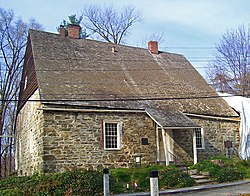
Washington's Headquarters State Historic Site, also called Hasbrouck House, is located in Newburgh, New York, United States, overlooking the Hudson River. George Washington lived there while he was in command of the Continental Army during the final year of the American Revolutionary War; it had the longest tenure as his headquarters of any place he had used.
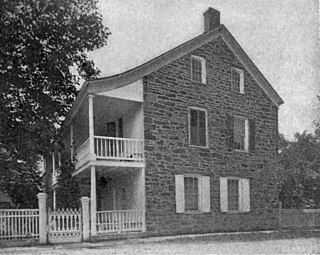
Louis Du Bois was a Huguenot colonist in New Netherland who, with two of his sons and nine other refugees, founded the town of New Paltz, New York. These Protestant refugees fled Catholic persecution in France, emigrating to the Rhenish Palatinate and then to New Netherland, where they settled in Wiltwyck and Nieuw Dorp (present-day Hurley, New York, settlements midway between New Amsterdam and Beverwyck before ultimately founding New Paltz.
Hasbrouck House may refer to:

Josiah Hasbrouck was a United States representative from New York. Born in New Paltz, he completed preparatory studies and conducted a general merchandising business. He was a second lieutenant in the Third Regiment of Ulster County Militia in 1780, and was supervisor of New Paltz from 1784 to 1786 and in 1793, 1794, and 1799 to 1805. He was a member of the New York State Assembly in 1796, 1797, 1802, and 1806.
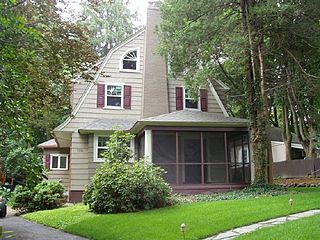
Dutch Colonial is a style of domestic architecture, primarily characterized by gambrel roofs having curved eaves along the length of the house. Modern versions built in the early 20th century are more accurately referred to as "Dutch Colonial Revival", a subtype of the Colonial Revival style.
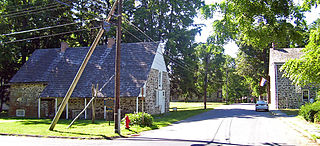
Historic Huguenot Street is located in New Paltz, New York, approximately 90 miles (140 km) north of New York City. The seven stone houses and several accompanying structures in the 10-acre National Landmark Historic District were likely built in the early 18th century by Huguenot settlers fleeing discrimination and religious persecution in France and what's now southern Belgium. After negotiating with the Esopus Indians, this small group of Huguenots settled on a flat rise on the banks of the Wallkill River in 1678. The settlers named the site in honor of Die Pfalz, the region of present-day Germany that had provided them temporary refuge before they came to America. Archaeological finds indicate that the immediate area settled by the Huguenots was occupied by Native Americans prior to European contact. The site is one of the oldest continuously inhabited settlements in the United States.
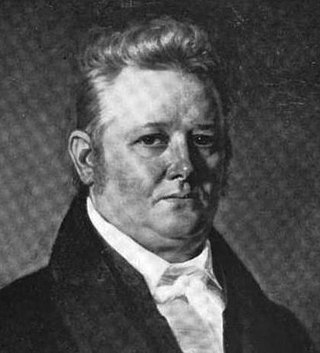
Abraham Joseph Hasbrouck was a United States representative from New York and a slaveholder.

The Bronck House, also known as the Pieter Bronck House, is a historic house museum west of Coxsackie in Greene County, New York. With a construction history dating to 1663, it is believed to be the oldest surviving building in Upstate New York, and is a well-preserved example of early Dutch and Swedish Colonial architecture. It was declared a National Historic Landmark in 1967. It is now a museum property managed by the county historical society.

The Montgomery–Grand–Liberty Streets historic district was the first of two to be designated in the city of Newburgh, New York, United States. It runs along the three named north-south streets in the northeast quadrant of the city and includes 250 buildings in its 1,010 acres (4.1 km2). The later East End Historic District is nearby.

The Crailo State Historic Site is a historic, fortified brick manor house in Rensselaer, New York which was built in 1707. The word Crailo is derived from kraaien bos and refers to Kiliaen van Rensselaer's estate in Huizen, Holland, which is also named "Crailo". Fort Crailo is listed on the National Register of Historic Places.

Locust Lawn is a surviving 19th-century farm complex situated on the bank of the Plattekill Creek on New York State Route 32, outside of New Paltz, Ulster County, New York.

William Cornelius Hasbrouck was an American lawyer and politician.

The John A. Lafevre House and School is located along NY 208 in the town of Gardiner, New York, United States. It is often believed to be in New Paltz as it is within that town's ZIP Code. The house is a stone structure dating to 1772; the school was built in 1835 and remained in use for almost a century. Both are well-preserved examples of their type of building and were listed on the National Register of Historic Places in 1989.

The Bevier House Museum, referred to simply as the Bevier House or Bevier Stone House prior to its conversion from a private residence, is located in Marbletown, near Kingston, New York. The house is also the home of the Ulster County Historical Society and is currently open to the public as a museum.

The Major Jacob Hasbrouck Jr. House is located on Huguenot Street in the Town of New Paltz, New York, United States. It was built in 1786 by Hasbrouck, grandson of Jean Hasbrouck, one of the original Huguenot settlers of the New Paltz area in the late 17th century, after he had moved out of the family home, two miles (3.2 km) to the south in what is today the Huguenot Street Historic District. A descendant of his lives in the house today, and it is believed to be the only 18th-century stone house in the New Paltz area continuously owned by the family that first built it.

The Kingston Stockade District is an eight-block area in the western section of Kingston, New York, United States, commonly referred to as Uptown Kingston. It is the original site of the mid-17th century Dutch settlement of Wiltwyck, which was later renamed Kingston when it passed to English control.

New Paltz is a village in Ulster County located in the U.S. state of New York. It is approximately 80 miles (130 km) north of New York City and 70 miles (110 km) south of Albany. The population was 7,324 at the 2020 census.

New Paltz is an incorporated U.S. town in Ulster County, New York. The population was 14,407 at the 2020 census. The town is located in the southeastern part of the county and is south of Kingston. New Paltz contains a village, also with the name New Paltz. The town is named for Palz, the dialect name of the Palatinate, called Pfalz in standard German.
The Hasbrouck family was an early immigrant family to Ulster County, New York, and helped found New Paltz, New York. The Hasbrouck family were French Huguenots who fled persecution in France by moving to Germany, and then the United States. Two brothers, Jean II and Abraham, are the ancestors of almost all individuals in the United States with the last name "Hasbrouck," or some variation.
